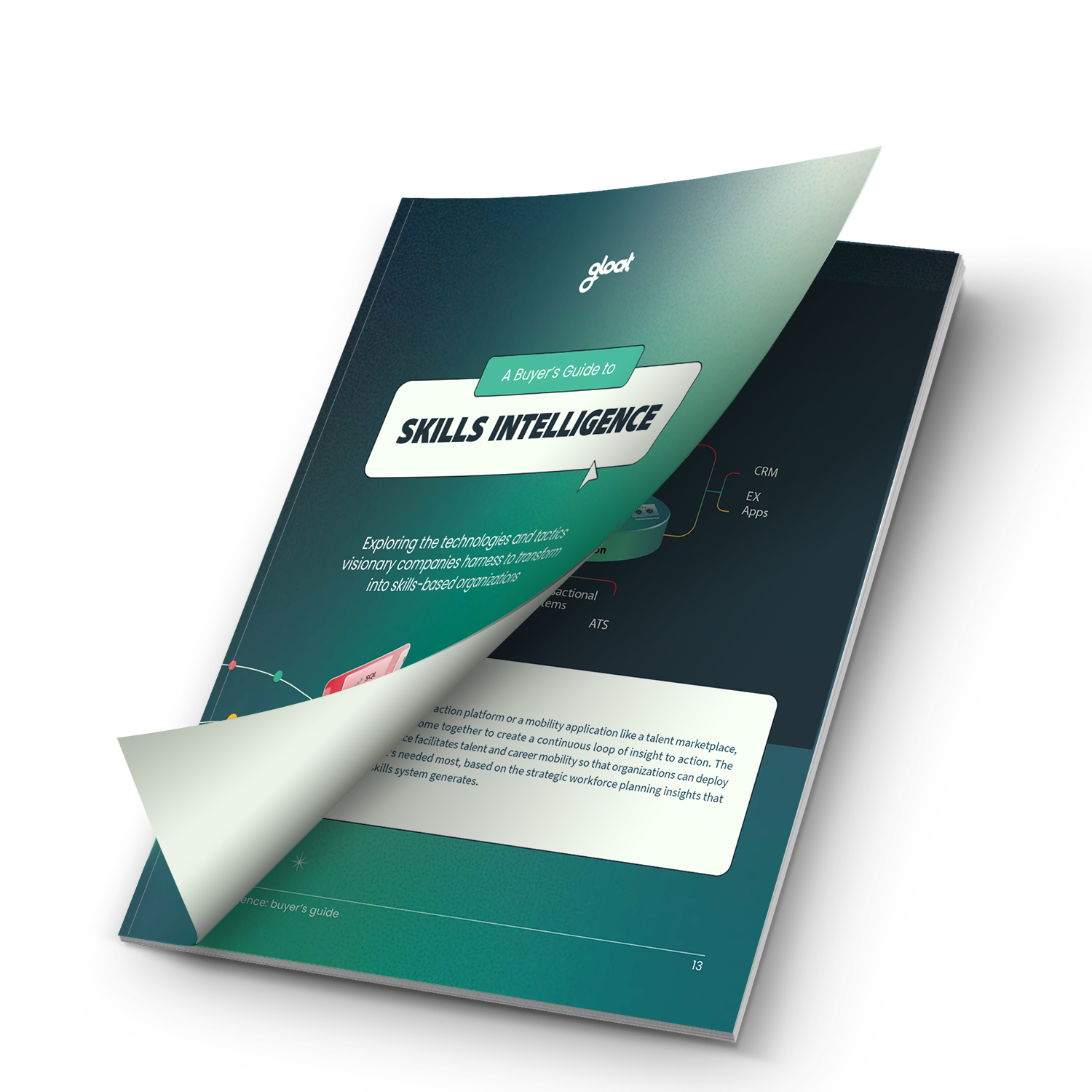How to develop a reskilling culture
Learn how to empower your people to build new capabilities

The launch of OpenAI’s ChatGPT in late 2022 opened up a new world of possibilities for businesses across the globe. Leaders are eager to integrate AI into their daily workflows to supercharge productivity and empower their people to spend more time prioritizing higher-level tasks.
While a future hallmarked by human-machine collaborations sounds promising, those visions for better ways of working will never turn into realities if companies lack key AI skills. Yet, many employees feel like they’re falling behind when it comes to preparing for the AI age. According to recent surveys, 86% of workers lack AI skills and only 45% believe their employer is helping them upskill or reskill.
So what does it take to set your organization apart from the pact and earn distinction as an employer that’s committed to helping people grow with your business? Ultimately, leaders must cultivate a culture that empowers their entire workforce to hone the skills that the future of work demands.
What is reskilling?
Reskilling is the process of helping employees develop new capabilities to enable them to improve their performance in their current jobs or transition to new roles. The training equips workers with skills that aren’t directly tied to their current position but are still valuable to both the company’s business priorities and the employee’s ambitions. For example, if a software engineer was looking to leverage their expertise in software engineering to apply to marketing roles, this employee would benefit from opportunities to train in copywriting and editing. Learning these types of skills would help them reskill so that they could move into a marketing role that aligns with the needs of their business, as well as their own career goals.
The importance of reskilling in today’s workforce
Reskilling is going to be particularly important in the years to come, as AI innovations promise to transform the way we work. Over the next five years, the World Economic Forum predicts that nearly a quarter of all jobs will change significantly and 69 million new roles will be created.
Given these forecasts, it’s easy to understand why so many organizations are kicking their reskilling efforts into overdrive. Since all skill-building initiatives aren’t created equally, it’s up to HR leaders to devise an impactful reskilling program that will unlock all of the potential benefits that these programs have to offer.
How do you prioritize reskilling?
With so many challenges on leaders’ agendas, some executives may struggle to prioritize reskilling. In particular, they might have uncertainty about which skills their people need to build first. Rather than guessing what knowledge may become more important in the future, leading companies are harnessing skills intelligence tools like Gloat’s Skills Foundation to ensure their learning and development processes are future-fit. These systems even include job and skill benchmarking, allowing leaders to see which capabilities are on the rise and on the decline, as well as how the competition is positioning their jobs so they can gain a leg up.
Leaders must also ensure their entire workforce has access to learning opportunities. In the past, reskilling was often reserved for a select few employees. Since everyone can benefit from learning new skills, executives should encourage people across their organization to participate in skill-building activities. Talent marketplaces can drive participation by generating suggestions for projects, gigs, and full-time roles that are tailored to employees’ skills and interests.
Benefits of reskilling the workforce for organizations
Some of the top benefits associated with cultivating a culture that prioritizes skill-building include:
#1. Reduce hiring, training, and consultant costs
When companies don’t prioritize reskilling, they usually need to rely on external hiring or bring in contractors to bridge emerging knowledge gaps. However, this often comes with a high price tag because it’s 1.7 times more expensive to recruit, train, and onboard new talent than it is to promote from within.
#2. Bridge the skills gap
Companies that prioritize reskilling are also generally more efficient. Instead of letting skill gaps delay internal processes and limit employees’ ability to pitch in on various tasks, organizations with effective skill-building programs can ensure their workforce has the knowledge needed to lend a hand to other departments and tackle high-priority challenges as they emerge.
#3. Increase employee engagement and satisfaction
If you want to retain your employees, think of skill-building opportunities as your first line of defense. It’s a surefire way to improve engagement and satisfaction because developing new skills gives people a sense of accomplishment and reinforces their value, both inside and outside of their organization.
#4. Future-proof your workforce
Reskilling enables employees to continue to prove their value to the business, even as consumer demands shift and priorities change. Rather than having to fear for their jobs, employees who work at companies that prioritize reskilling can feel confident that they have the pathways needed to build knowledge that will enable them to move into another role within their organization.
#5. Retain company knowledge and processes
Employee turnover comes with a high price tag. In addition to the costs associated with recruiting, bringing new hires up to speed is a challenging process because they must get familiar with internal processes. Once employees have built up their organizational knowledge, it’s in every leader’s best interest to work hard to retain them—and reskilling is a smart way to do that. When employees feel like their employer is supporting them through their development journey, they will feel more connected to their organization and more eager to stay on board.
Benefits of reskilling for employees
Cultivating a culture that prioritizes reskilling also has many benefits for employees, including:
#1. Increased job security
Reskilling helps employees continue to prove their value to the business, even as consumer demands and priorities change. Rather than having to fear for their jobs, employees who work at companies that prioritize reskilling can feel confident that they always have the pathways needed to build knowledge that will help them stay relevant to their employers.
#2. Expanded career opportunities
Additionally, reskilling initiatives pave the way for upward and lateral mobility. Employees who participate in reskilling initiatives to expand their scope of knowledge will be able to take their careers in new directions that align with their ambitions and eventually qualify for more senior roles.
#3. Improved job satisfaction and engagement
The more opportunities employees have to take their careers in new directions, the more likely they are to feel fulfilled by their work and engaged in their jobs. A Gartner survey of 3,500 employees revealed that when organizations close the gap on employee career growth expectations it can have up to a 45% positive impact on employees feeling supported in their careers.
#4. Greater flexibility and adaptability
When employees continuously grow their skill sets, they become better equipped to take on a wider array of projects and growth opportunities that may arise. From pitching in on a last-minute presentation to helping customers resolve problems, reskilling prepares people for whatever challenges come their way.
#5. Higher earning potential
There’s often a correlation between skill-building and earning potential. As employees add new skills to their repertoire, they’re able to command a higher salary, reflecting the increased value they bring to their roles.
How to develop a reskilling culture
If you’re eager to encourage your workforce to level up its skill-building efforts, here are a few steps to get started:
#1. Leadership commitment and role modeling
Leadership sets the tone for culture—and skill-building is no exception. Executives should strive to partake in their own development opportunities, such as honing new skills that will help them make strategic decisions about generative AI use cases. Rather than keeping these learning endeavors to themselves, leaders should talk about their experiences openly and promote them on social media to encourage other employees to follow in their footsteps.
To go the extra mile to create a learning culture, leaders and managers must also move away from talent hoarding mentalities and instead encourage team members to try new things and contribute to projects elsewhere. Prioritizing talent sharing will enable employees to build stronger working relationships with peers across the organization and ensure that managers always have somewhere to turn when looking for an extra set of hands for a high-priority project.
#2. Assess and identify skill gaps
Before launching a reskilling initiative, leaders need to take a step back and assess where skills lie, what knowledge gaps are emerging, and the areas of expertise that will be most valuable to hone. To create this in-depth understanding, many executives will conduct a skill gap analysis to pinpoint which learning and development initiatives should be prioritized.
Once leaders are aware of their organization’s knowledge gaps, they can use AI-powered skills intelligence tools to identify employees with transferable skills who can be reskilled to fill high-priority roles. The systems can show different ways to bridge existing talent gaps by reskilling internal talent as opposed to external hiring.
#3. Create personalized learning pathways
While content-based lessons can help employees get familiar with a subject, hands-on experience is essential for building genuine expertise. To help employees deepen their understanding of various areas of the business, everyone should be encouraged to participate in projects and gigs within other departments. Many visionary companies are harnessing talent marketplaces to generate suggestions for projects, gigs, and even full-time roles that align with employees’ current skill sets and career ambitions.
#4. Make it easy to find development opportunities
Even when leaders invest in pathways for learning and career development, many employees struggle to take advantage of them because these resources are dispersed among a wide array of tools and systems. Since companies have an average of 70 different applications for employee development, there’s often uncertainty about where to go to find various skill-building resources. Instead of letting siloes and bottlenecks hold people back, leading companies are utilizing an opportunity hub to centralize all volunteering, learning, and training resources—in turn encouraging employees to take advantage of them.
How to create a successful reskilling program
If you’re looking to create a reskilling program that benefits your people and your business, here are 6 steps to get started:
#1. Assess current skills and identify gaps
Leaders should stake stock of all the capabilities their workforce has, including those carried from previous jobs. Keeping tabs on workforce skills is frequently challenging because this information is often siloed in a few different HR systems.
Rather than settling for a subpar understanding of workforce skills, companies are harnessing skills intelligence systems like Gloat’s Skills Foundation to gain visibility into their people’s capabilities. Executives can also use these systems to identify where skill gaps are emerging and compare their workforce’s skill sets to benchmarks based on their industry.
#2. Set clear objectives and goals
Once leaders have an idea of where skills lie, they should begin developing a series of goals to guide their reskilling initiative. Skill-building objectives should align with the needs of the business and help the organization deliver on its enterprise-wide priorities. Stakeholders from across the organization should offer their input to ensure skill goals reflect the needs of the business at large.
#3. Design training programs
The most effective skill-building strategies will include both content-based L&D courses as well as experiential learning opportunities that give employees a chance to put the lessons they’re learning into practice. To ensure all workers have access to these hands-on learning opportunities, many companies are turning to talent marketplaces. The platforms generate suggestions for projects, gigs, and full-time roles based on an employee’s skills and career goals.
#4. Secure leadership and employee buy-in
To maximize the success of your reskilling initiative, leaders across your organization should be on board with it. Ensure all stakeholders have an understanding of the skills your business needs to build and how your skill-building plan will help employees hone these capabilities. When leaders are excited about the program, they will share this enthusiasm with their teams and encourage them to participate.
#5. Leverage technology
The best skill-building initiatives are grounded in insights about emerging knowledge gaps and future skill needs. Instead of trying to guess which capabilities your people should hone first, leaders can harness skills intelligence systems to get this information at their fingertips. The best solutions will be able to forecast skills that are rising in demand as well as those on decline so executives can update their skill-building strategies accordingly.
#6. Monitor progress and measure success
Following the launch of your reskilling strategy, make sure to monitor how the initiative is going and see how your progress aligns with the goals you set to guide the program. Source feedback from managers and employees to uncover skill-building success stories that you can spotlight on social media and on your intranet to help get more of your workforce excited about the initiative.
Measuring the impact of reskilling programs
There are plenty of different ways to assess the impact of your reskilling program. Leaders can launch surveys to get feedback on the types of reskilling that employees find most rewarding as well as potential areas of improvement. Executives can also set goals for participation to see how engaged employees are.
Additionally, retention rates can help shed light on how your reskilling program is doing because typically employees with ample growth opportunities are less likely to leave the organization. Finally, productivity rates and project completion metrics can highlight the success of your reskilling program because employees with more capabilities will be able to work more efficiently and pitch in on an array of projects.
The urgency of reskilling
Skill-building has always been important but recent events are raising the stakes. We’re now in what’s often called “The Fourth Industrial Revolution”, a time in which advances in AI and automation are revolutionizing the way we work.
Now that the pace of change is accelerating and the half-life of skills is shrinking, developing new competencies can no longer be an afterthought. Since research points to emerging skill needs and the creation of many new jobs in the coming years, it’s up to leaders to prepare their people for these shifts. New jobs will come with new sets of required knowledge, which is where the increased need for reskilling comes into play.
Reskill your workforce in the age of AI
The rise of generative AI only reinforces the sense of urgency around today’s skill-building imperative. More than one-third of employees report that their organizations are already using generative AI in at least one function and 40% say their companies expect to invest more in AI overall.
As businesses explore new AI use cases, the skills their workforces need will undoubtedly change. AI-powered tools are likely to take on many administrative tasks, meaning employees who are currently responsible for this work will need to hone new skills to complete functions that are higher-level and more strategic. Consequently, leaders must develop reskilling initiatives to prepare their people for a future of work that’s hallmarked by human-machine collaborations.
To learn more about how skills intelligence tools can help your organization prepare for the future of work, check out our skills-intelligence buyer’s guide.





